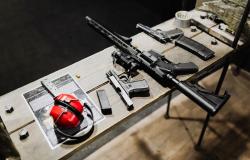The Blessings of Government

Scott Montgomery explores the rise of the gun as the icon, symbol, and supposed requirement of freedom, of contemporary USA.
Today is Memorial Day, a holiday to honor and mourn military personnel who died while serving to protect the security of the U.S. The War in Afghanistan, lasting two decades, resulted in 2,300 combat deaths and 21,000 wounded, many with profound levels of PTSD. During that same period, over 400,000 people, including 23,000 children under 18, were killed by firearms in the homeland. The ultimate sacrifice by those who fought to prevent another 9/11 should perhaps be weighed against the spread of terror and trauma in country by Americans themselves. In the week leading up to Memorial Day, 23 Americans were killed and hundreds wounded in 260 mass shooting events across the country.
___________
There exists by now a library of books and essays taking to task America’s gun situation. Only a few of these writings, however, have brought forward a brutal honesty that their authors understand but feel perhaps might be counterproductive. But as the death count continues to rise from willful, malicious, and accidental shootings, as well as suicides, affecting people of all ages in every state, it seems that fierce truths should be spoken.
Here is one: Republicans have been effectively murdering Americans for decades. In striking down any and all restrictions and responsibilities for owning guns, they have been handing out loaded weapons to all who may see a use or purpose for them, in whatever kind of moment of “need.” In the past year, after hundreds of mass shootings, the GOP response has been to pass state laws expanding the right to own multiple guns with no need for a license, no requirement for training, and virtually no limit to carrying them, whether openly or concealed. But they have gone still further. After an attack on a school in Nashville that killed six people, the Republican-dominated Tennessee legislature passed a bill to protect gun manufacturers and sellers from any lawsuits by the families of victims.
Blaming Republicans for murder is no stretch of anyone’s imagination. The party’s response to mass shootings for over 20 years has been tantamount to giving a child a set of steak knives after discovering she routinely cuts herself. There are now 26 states who allow people to carry loaded firearms in public, openly or hidden, without any kind of license or permit. During the Obama Administration, many GOP members endorsed such slogans of the NRA (National Rifle Association) as: “An Armed Society is a Polite Society” and “An Armed Man is a Citizen. An Unarmed Man is a Slave.” People interviewed at gun shows continue to prove their allegiance to this sensibility: when asked why they are there, the overwhelmingly answer is: “self-defense” or “protection.” Such, of course, is nothing other than a confession of living in fear.
At present, nearly half (46%) of U.S. households are estimated to have at least one firearm, while a 2021 National Firearm Survey indicated 32% of Americans over 18 years of age personally own one or more. Assuming the latter figure has not greatly altered, it means that at least 110 million people are gun owners. To the rational mind, this would qualify as an “armed society” under any circumstances. But for the Republican Party, it remains too small. Any existing laws that might restrict gun ownership to the slightest degree are fair game for assault.
____________
Other numbers are helpful. Global figures on small arms indicate around one billion in worldwide circulation, with 85% (857M) in civilian hands, 13% (133M) in military arsenals, and 2% (23M) used by law enforcement. The U.S. civilian population currently owns an estimated 400M firearms, thus three times all the world’s militaries combined. This might seem a comparison with several meanings. The most obvious is that Americans have an excellent reason to fear each other. Also: the U.S. armed forces have the same reason to largely confine themselves to well-protected military facilities.
There is a perception that the large number of wars America has pursued since 2001 has brought a steady stream of combat veterans back into the country, inflating the gun rights movement and normalizing the acceptance of military-style weapons. My own experience casts some doubt on this. My classes over the past 15 years have routinely included military people, including veterans, many of whom were deployed in Iraq and Afghanistan. What disturbs many of them is that laws in Republican-dominated states have created a situation where ordinary citizens are legally allowed to carry weapons to a greater degree than are soldiers on many bases. Indeed, military leaders split company on whether troops on base should be able to carry guns. Meanwhile, over 75% of Veterans in a survey reported by the journal Veteranlife think gun violence in America is a major problem, and 49% feel that both mental health and gun legislation (i.e. lack thereof) contribute to shooting incidents. What to conclude from this?
The far-right prefers that America be at war, at home, and with itself. They have their wish. In 2017, the Pew Research Center found that 36% of Americans could see themselves buying a gun in the future, thus increasing total ownership to more than two-thirds of the population. Why? Because, as claimed by 70% of adults—75% of gun owners—"the world has become a more dangerous place.” By “world,” of course, respondents don’t mean Myanmar, Senegal, or Greenland. They mean the U.S. itself, any local part of it. The loop closes itself: fill up a country with lethal weapons, remove all or nearly all legal accountability for owning them and bearing them, and see what happens.
The experiment could never have had but one result. What could possibly go wrong when hundreds of millions of firearms are given, without accountability, to a vast population bristling with polarized camps, forced inequity, racism, underemployment, broken families, abusive relationships, rural blight, massive drug abuse, extremist groups, cultural war, identity theft, deaths of despair, the world’s largest prison population, deinstitutionalized mental healthcare, and an economic system that is the very embodiment of injustice and predatory exploitation?
_______________
On April 19, 1995, Timothy McVeigh set off a truck bomb that destroyed the Alfred P. Murrah Federal Building in Oklahoma City, killing 168 people, including 19 children in a daycare center. Less than 90 minutes later, McVeigh was stopped by highway patrol for driving without a license plate and then arrested when he couldn’t produce a permit for the 9-mm Glock 21 he was carrying under his jacket. Today, in the same circumstance and same state, no such arrest would be made.
McVeigh was a domestic terrorist. Mass shooters are terrorists too. What qualifies them as such is that, as a group, they are the most successful domestic producers of fear in American history. People in the U.S. are now everywhere anxious about the possibility of being caught in a shooting incident, afraid for themselves, their children, loved ones, friends, neighbors, work colleagues, students, teachers, afraid to a degree that foreign terrorists could only envy. This is because there are absolutely no safe places to be or to live: maps show that mass shootings, gun accidents, collateral (unintended) injuries, and more now happen in every state, in urban, suburban, and rural areas. Incidents can occur anywhere, be it in a church or synagogue or mosque, a school or university, a public park, department store, movie theatre, parking lot, music concert, restaurant, workplace, even Congress itself. Ages for mass shooters range from 16 to 70. The only truly consistent aspect is that 97% of these killers are men, roughly 60% of whom are white.
_____________
That these shootings are so widespread geographically, variable in motive and perpetrator age, and random in occurrence confirms two things. First, there is reason for Americans to be apprehensive about their safety. Second, the problem is societal. Individuals are the immediate killers, yes, but their number and the factors just noted make it obvious they are not purely self-created. They emerge from a society that has become increasingly rancorous with inequity, incapable of caring for its needy and desperate, bitterly divided in its cultural and political loyalties, and warped by the mainstreaming of violent and extremist ideas such as the “great replacement” conspiracy (whites to be replaced by dark-skinned people). There is also the reality that intense media attention offers a shooter the image of efficacy and national attention to a final act. All of which underlines, once again, why the GOP’s relentless policy toward making guns more available makes it a murderous organization.
The greatest rise in the number of firearms has taken place since the mid-2000s, when Republicans let the federal assault weapons ban elapse. The figure grew most rapidly during the presidency of Barack Obama, in no small part due to conspiracy ideas about his plan to make it more difficult to buy firearms or to have government agents (FBI, ATF, DEA, etc.) even confiscate privately-owned weapons. These, too, were ideas propounded by GOP, especially in election campaigns. Much can be said about the dimensions to such beliefs, but there is one truth that sails above the rest.
The flood of firearms in 21st century America is a revelation of the country’s decay into illiberalism. As an icon, symbol, and supposed requirement of freedom, the gun has been a part of fringe populism reaching back into the 19th century. Today, such extremism and the political party that feeds on it and thereby nourishes it are the major source of more casualties by firearms—according to the Centers for Disease Control, 757,000 since 2000—than were killed by the Nazis and Japanese in WWII, and in all military conflicts involving U.S. soldiers thereafter. Not even the Mexican cartels can compete with such numbers. It seems curious, then, that many Americans are afraid to go there on vacation. With the blessings of government, they continue to feel safer at home.
Photo by Karolina Grabowska


